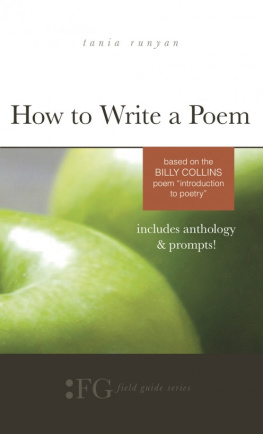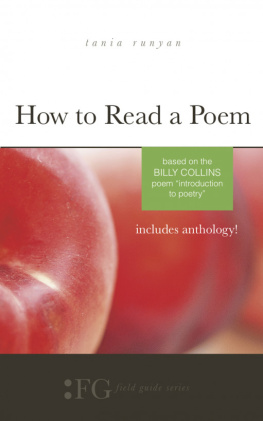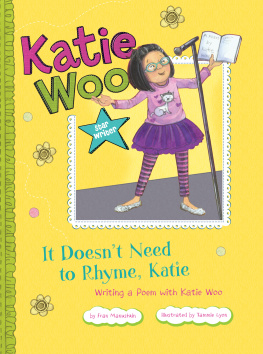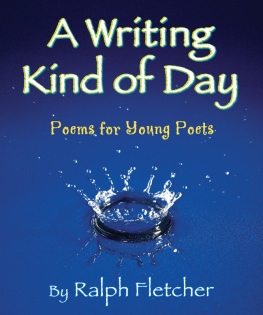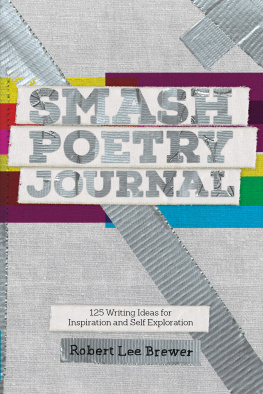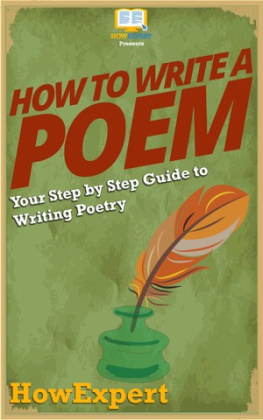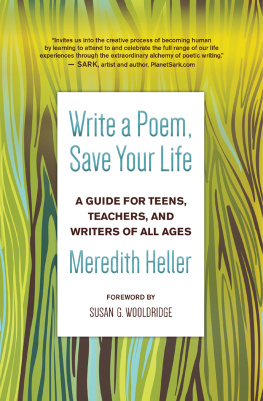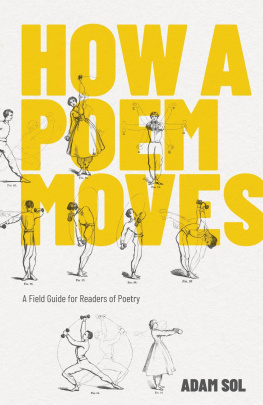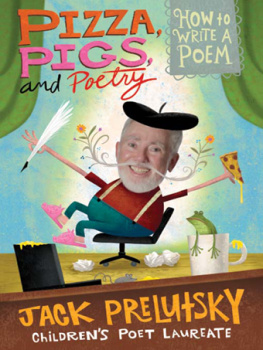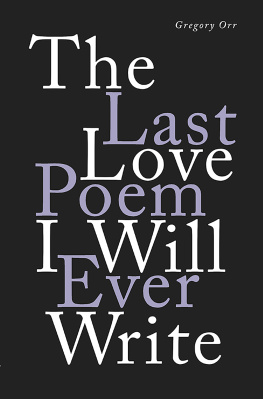a post-it note
ive put some
poems
in the icebox
theyll be cold
and sweet
when you get home
william marr
How to Write a Poem
based on the Billy Collins poem
introduction to poetry
t a n i a r u n y a n
field guide series
T. S. Poetry Press New York
T. S. Poetry Press
Ossining, New York
Tspoetry.com
2015 by Tania Runyan
All rights reserved. Do not reprint withoutpermission.
This book includes various references fromor to the following companies, brands, and sources: IKEA; TheMaking of a Poem: A Norton Anthology of Poetic Forms by EavanBoland and Mark Strand, W. W. Norton & Company, Reprint 2001;Facebook; Instagram; Twitter; Popsicle, a trademark of Unilever;Caravan, a model of Dodge, which is a division of Fiat ChryslerAutomobiles; Singer.
Cover image by Sonia Joie soniajoie.com
ISBN 978-1-943120-13-0
Library of CongressCataloging-in-Publication Data:
Runyan, Tania
[Nonfiction/Poetry.]
How to Write a Poem: Based on the BillyCollins Poem
Introduction to Poetry
ISBN 978-1-943120-13-0
to jeremy, who has walked the lines withme
Contents
4. Lay a Path: Pay Attention to Line
How to Use This Book
You are invited. And the party is all aboutyour words: how to find them, express them, and perfectthem.
Of course there is no formula for writing apoem. If poems came with instructions like IKEA coffee tables,wed all be missing the point. But this book will give you somestrategiessome tools, if you willto assemble your personal,imaginative raw materials. These strategies are focused primarilyon free verse (for a comprehensive look at form poetry, which isone tried-and-true way you can start a poem, I recommend TheMaking of a Poem: A Norton Anthology of Poetic Forms). Yet,many of the concepts can also be applied to form poetry, at boththe inception and revision stages.
Each chapter will introduce and model,through several drafts of the same sample poem, a concept you willexplore in your own draft. You will continue to reshape your poemfrom chapter to chapter, ending with a thorough revision. And thenyou can start again with a new poem. Write and repeat. These arepoetry-crafting strategies for life.
How to Write a Poem is written as acompanion to How to Read a Poem , whichuses Billy Collinss Introduction to Poetry as a guide forenjoying poems. Like How to Read a Poem, this book isorganized by chapters inspired by stanzas from Collinss poem.While the two books work well together, they also functionindependently. (Do keep in mind that the best poets spend at leastas much time reading and absorbing poems as they do creating theirown.)
Your words are waiting. Are you ready tobegin?
Introduction to Poetry
Billy Collins
I ask them to take a poem
and hold it up to the light
like a color slide
or press an ear against its hive.
I say drop a mouse into a poem
and watch him probe his way out,
or walk inside the poems room
and feel the walls for a light switch.
I want them to waterski
across the surface of a poem
waving at the authors name on the shore.
But all they want to do
is tie the poem to a chair with rope
and torture a confession out of it.
They begin beating it with a hose
to find out what it really means.
Introduce Yourself: Find the PoemsInside
To a Poet, For a Poem
Jennifer Wagner
I listen to the darkness,
the beautiful kind
when the lights are off,
and I close my eyes
and see the last light
burned into my mind.
I sit, in my poetry nook,
in the corner of the room,
in a chair, arms leaning, at rest,
my feet propped.
I listen, listen,
ceiling fan low,
box fan high, pointed toward me
to carry the sound
of the silver crackle
of the millionth star
no less wonderful
than the first.
And it might be yours, the only light
in this dark room tonight.
The Poetry of Imperfection
Poetry is about freedom and the imagination.Ocean waves and flying geese. The human spirit, for cryingout loud. Shouldnt I just jump right in?
Yes and no.
Yes to invitingimmediately andenthusiasticallythe images, feelings, and ideas bubbling in yourpen or keys. No to crafting that perfect poem rightaway.
As a young, perfectionist writer in college,I spent hours chiseling away at the perfect lines, one line at atime, in my poems. I wouldnt proceed to the next lineevenworduntil I believed Id arrived at a previous final product. Theresults? Really technically expert poems. And not that muchpassion. Id often forget what imaginative impulse had driven me towrite in the first place because of my stilted approach.
Since then, Ive learned how important it isto be free, open and fluid when beginning to write in order to letthe poem find itself. Am I against revising? Absolutely not. Infact, by the time Im done with you, you may wish the conceptdidnt exist. But to start, you must create an environmentconducive to finding the poem inside. In fact, I recommend startingwithout a poem at all.
Freewriting
Peter Elbow, author of Writing WithoutTeachers, coined the term freewriting in 1975. You may havetried it before: setting aside a certain amount of time, say, fiveto fifteen minutes, during which you write your thoughts withoutstopping, censoring, or editing in any way. While Elbow firstpromoted the practice for helping students in the classroom getstarted with papers, the process works well for all genres. I useit when I begin essays, fiction, and, always, poetry. The thinkingbehind taking this all-important first step? Preserving your voice,the poets lifeblood:
The habit of compulsive, premature editingdoesnt just make writing hard. It also makes writing dead. Yourvoice is damped out by all the interruptions, changes, andhesitations between the consciousness and the page. In your naturalway of producing words there is a sound, a texture, a rhythm--avoice--which is the main source of power in your writing. I dontknow how it works, but this voice is the force that will make areader listen to you. Maybe you dont like your voice; maybe peoplehave made fun of it. But its the only voice youve got. Its youronly source of power.
When you start with freewriting, youensure that the spark of your voice takes precedence over linebreaks, commas, spelling, and yeseven sense. You start in order tosee where you need to start. You start with power.
Focused freewriting, or writing inresponse to a topic or prompt, offers a poet the benefit of freeingthe voice within a general structure so she has some branches tohang her thoughts on. The prompt offers a focus, but you shouldnever chain yourself to it. Use it as a base from which toexplore.
Freewriting Starts
Now its time to find the poems inside. Therules are simple:
1) Skim the list and choose a topic
2) Set a timer for ten minutes
3) Write or type without stopping
4) If you get stuck, keep writing I dontknow what
to write until more thoughts return
5) If the alarm goes off and youre in deep,keep going
Your first memory
A local injustice
The ugliest place youve visited
A best friend youve fallen out of touchwith
A curious adult from your childhood
A meal that changed your life
A song that haunted you in high school
Someone who loved you whom you didnt loveback
A Facebook status or tweet
Something you found in the road
A tour of your home town
Two famous people meeting outside of theirtimes
Lessons for your child/friend/lover
Something odd your parents owned
Next page
